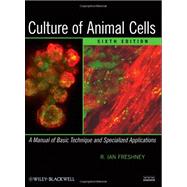This is the most complete resource on the techniques, equipment, principles, and practices of animal cell culture.
Since publication of the previous edition of this benchmark text, numerous types of equipment and materials have changed and new specialized techniques have been developed, particularly in the area of stem cell research and tissue engineering. These and other developments have been incorporated into this rigorously revised and expanded sixth edition of Culture of Animal Cells, the leading text in the basic methodology of cell culture.
This authoritative volume offers a complete background related to growth of animal cells in culture. It contains many specialized protocols and advice on how to apply some of the basic protocols to teaching cell culture. Beginning with laboratory design, safety, validation, and bioethics, then continuing with preparation of media, primary culture, and cell lines through to characterization and authentication, contamination, specialized techniques, and troubleshooting, the unparalleled coverage includes:
-An all-new section addressing the additional caution required once a primary culture is converted to a cell line
-Differentiation in stem cells and reprogramming of adult cells to form stem cells
-A new section and protocol on cryopreservation by vitrification
-Separate sections dealing with epithelial cells, mesenchymal cells, neurectodermal cells, and hematopoietic cells, a new chapter on germs cells/stemcells/amniocytes
-A new section on organotypic culture
-Increased emphasis on contamination and misidentification including cross contamination with revised protocols for detection and elimination
-A problem-solving chapter, glossary of terms, advice on sourcing materials, and list of suppliers
This landmark text presents the most accessible and comprehensive introduction available to the culture and experimental manipulation of animal cells and is indispensable for those in the field, including clinical and biopharmaceutical researchers and scientists, graduate students, laboratory managers in cell and molecular biology labs and genetics labs, trainees, and technicians.








